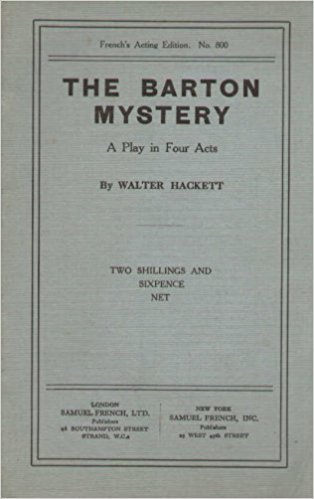By Walter Hackett (1876-1944).
1916.
Before television and radio, audiences could get their mystery thrills from stage productions. Here are excerpts from three contemporary reviews of a popular mystery play of the time:
WRITERS of detective stories, whether for the stage or in the form of a novel, would be well advised to stick to the general principle that in this type action, mental and physical, is all-important. . . . The general public has apparently made up its mind that this is an artificial genre manufactured for the express purpose of sharpening its wits. — F., "Reviews of Plays: The Barton Mystery," THE NATION (October 25, 1917)
One of the most difficult feats of juggling is, I understand, the deft tossing up and catching of a heavy weight (say a dumb-bell), a very light weight, such as a champagne cork, together with any old thing of irregular shape, a bedroom candlestick, for instance. Mr. Walter Hackett's The Barton Mystery is a most ingenious turn of this sort.
The fiancé of the sister of the wife of Richard Standish, M.P., is under sentence of death for the murder of Mr. Barton. He happens to be innocent, though he admits at the trial that he quarrelled violently with and even threatened Barton on the night of the murder, and his revolver has been found by the dead man's side. That vindictive relict, Mrs. Barton, is holding back some material evidence which could save the condemned man, or so Standish thinks, and she is adamant. Now Barton was unquestionably a bad egg, but the widow doesn't want the whole world to know it—at least not till she finds the woman. Some woman, who had incidentally written some, shall we say, very impetuous love letters, is being shielded. Who is she? Is it Standish's wife, for instance? Ah!. . . This is the dumb-bell. — From PUNCH (March 29, 1916; scroll down to more than halfway)
It is a play which gives frequent evidence of a deft touch, but it is, on the whole, so episodic and loosely knit that the effect of its mystery is constantly spending itself before it can become cumulative. . . . The unraveling of the mystery is done with not a little ingenuity, and suspicion is rather cleverly and convincing-ly thrown upon the wrong person. — THE NEW YORK TIMES (October 15, 1917)The Barton Mystery was filmed in 1920, 1932, and (in France) in 1949.
Another popular mystery play of the period is mentioned in THE NATION article, The Thirteenth Chair, filmed in 1919, 1929, 1937, 1953 and '54 (both for American TV), and 1980 (Spanish TV). The play itself is online HERE.
Category: Detective fiction

+-+Posed+cast+shot.jpg)

No comments:
Post a Comment